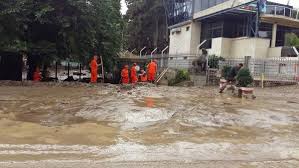Nino Tsotsoria
Several hours of rain in Tbilisi, on June 13, flooded river Vere. As a result, the river overflowed from its banks, flooded Heroes Square, and its adjacent areas. Up to 20 people died during the disaster, 3 are still missing. The flood destroyed the zoo. One part of the animals drowned in the water, some of them were liquidated after the escape. Road surface and infrastructure is destroyed. Total damage is approximately 100 million Lari.
At the conference, held by the Caucasus Environmental NGO Network (CENN), an expert-geologist Tchitchiko Janelidze and hydrologist Tsisana Basilashvili discussed the reasons that caused the flood on June 13. Representatives of NGOs and governmental sector have attended the conference.
The main natural reason that caused the flood is heavy rain that lasted for several hours. It created large amount of surface water on the slopes of the valley. One of the main reasons is also a destroyed forest zone, which almost completely lost the function to prevent sediment runoff. An artificial reason of this flood, as mentioned in the survey of the CENN, is incorrectly conducted agricultural works at the last section of Vere’s river bed.
“It is not difficult to explain objectively why the disaster happened. There are two factors – natural and human factor. For the natural factor, it has to be considered how the river layer is created. The layer of the river is counted with water that comes from atmospheric precipitation and its distribution; how sediment is distributed in time. At night of the disaster, after 3-hour rain, 80mm sediment came in the basin of Vere. So, the sediment that should have been distributed on 2 months, came in 2-3 hours. This caused creation of large flow of water, which accumulated in the river bed,”-said Tchitchiko Janelidze.
According to him, to prevent floods, it is necessary to have 40-50 year old tree surface in the river valley, whilst the tree surface in Vere valley is decreased to 8% to 0.4% and trees older than 20 years almost do not exist there. According to this, the forest has lost water-retaining function. As Tchitchiko Janelidze explains, river Vere has also no waterproof feature that had been developed for thousand years. Because of this, water no longer fits in the river bed and leaved the boundaries of a grove.
“Somehow they relate this disaster to the road constructed from the zoo, but this is not true. When they put the pipe in the Vere valley, engineers made irreparable mistake, because that pipe was designed for that time water impermeability of Vere. However, later, the river lost this feature and in 1961, during the similar flood, the water could not pass through the tunnel and gathered under the Heroes Square. This accumulated water made the river to rise higher. Today’s tragedy was caused not by the water from the sky, but by this underground water. Water rose up to 7 meters and covered the zoo, Heroes Square and Laguna Vere. The reason of this is a tunnel that was made in 1931. But nobody speaks about this,”- said Tchitchiko Janelidze at the meeting.
The expert also talked about the human factors of June 13 tragedy and explained that building houses on the grove of Vere valley is a negligence by people and safety measures are not protected.
“Leading workers received lands within Tbilisi area for temporary ownership. These were plots for land processing. The owner built cabins there. Then the Government has changed, the new Government came and the owners built houses instead of the cabins. Worse crime than this is construction of high-rise buildings in this area. The surrounding area of river Vere is a grove. Everyone knows that the grove is an elevated area on one slope, which is waterlogged during heavy floods. This is a trivial truth and no one wants to understand this truth,”- says the expert Tchitchiko Janelidze.
According to the geologist, this kind of heavy flood will be repeated in future and people have to be prepared for it.
“There is a term in hydrology – recurrence intervals, 1 %, 0.1%, 0.01%. This means that in 10 years, 50 years, 100 years or in 1000 years there will be flood. We do not know in which season it will happen, but it happened in 1961, this year and it will occur in future too. This is inevitable and everyone has to realize it. Existing tragedy is not fault of nature. It is an unwritten law of nature and nature always does that. People cannot fight against it. The consequences that we face today are results of unwise and illogical actions by humans,”- explained the geologist Tchitchiko Janelidze.
According to the analysis of CENN, two underground tunnels could not release the large amount of water flow because of lack of diameter. Also the catastrophe was caused by blocked wooden logs and branches brought by water flow. Pounding the stream caused the rise of the river level and flooded surrounding areas of tunnels.
Hydrologist Tsisana Basilashvili, relates the disaster to the absence of researches, According to her, after 90s, river flows are no longer recorded, so it is hard to do objective analysis, because water content is variable and it cannot be measured only with the surface level.
“River Vere begins from the bridge of Didgori, with the height of 1670 meters. Its space is 200 square meters, forest cover is decreased from 8 to 0.4%. A forest is very important to retain floods. Unfortunately, deforestation causes tragedies. It is important that people do not cut trees as they desire and without following any rules. During the rain in Vere valley, logs and cut trees came down and blocked the river bed. This caused water congestion. As we know the landslide occurred at 1am. This landslide of course contributed to the tragedy but the bigger disaster happened before 1am. Besides, there were other contributing factors. Because it was raining in previous days, the ground was humid, which prepared this mass to collapse during the heavy rain,”- said the hydrologist Tsisana Basilashvili.
According to experts, freshet starts in the case of 20mm precipitation. On June 13, 49mm precipitation occurred during one night. According to Tsisana basilashvili, human and artificial reasons of the disaster are both important factors while examining the causes of the disaster.
“People misappropriate the river valley and groves without asking. They built houses there, which is inadmissible on the groves. You cannot deny the presence of danger. People do this self-assumed and they do not think what kind of complications it might cause in future,” – said Tsisana Basilashvili at the meeting.
According to the analysis of CENN, the way out from the existing situation is quite difficult, because nature has its own unwritten laws and flood like June 13 will be repeated in future. To avoid the disaster, it is necessary to restore the natural morphological appearance of the river valley. According to the recommendation of hydrologist Tsisana Basilashvili, we should cleanup the river bed, increase depth to it and build banks by using extracted ground. According to her, it is required to terrace plateaus and start transverse plowing and sowing, so during the irrigation, direct flow of the water will not increase the danger.
According to the analysis of CENN, to restore the forest for a long time, to build small reservoirs in the river valley and increase the diameter of culverts. As we know, nowadays, the existing tunnels can only handle water flow with volume of 40-50m2/sec, while according to the observations of head of hydro meteorological station Merab Alaverdashvili, the maximum river flow of Vere ,on June 13 2015, exceeded 400-500m2/sec.
It has to be considered that, since 2000, examination, analysis and monitoring related to state of natural disasters in Tbilisi area has been no longer the responsibility of National Environmental Agency. Analysis of the natural disaster risks and preventive measures has not been conducted for 15 years.
We remind you, on June 13 the river Vere flooded the main part of the city center, which resulted into the death of 20 people and damage in amount of 100 million Lari.




